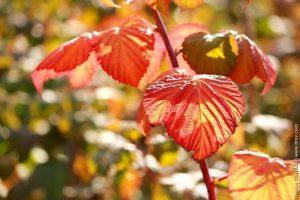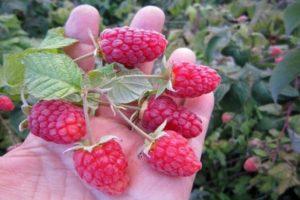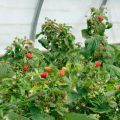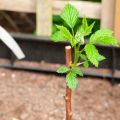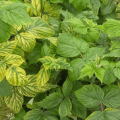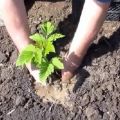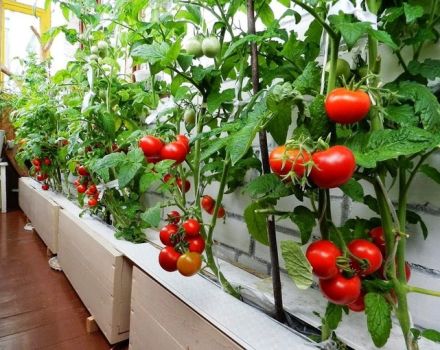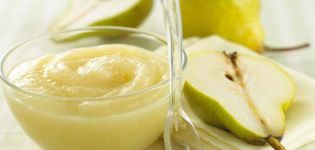Description and characteristics of the Gusar raspberry variety, yield, cultivation and care
Breeders pay great attention to repairing raspberry varieties because they are in demand by gardeners in all regions of Russia. Bred by the "father of remontant culture" I. Kazakov, the raspberry variety Gusar can bear fruit twice a summer. Moreover, the second period of berry ripening does not end with the first frosts.
Description and characteristics of the Gusar variety
The difference between raspberry Gusar and other varieties is that the plant:
- bears fruit twice - in June and August;
- resistant to diseases and pests;
- withstands frost and temperatures below 25 degrees;
- famous for its harvests of 5-6 kilograms of berries from a bush.
Raspberry Gusar tolerates reproduction easily, so it can grow quickly throughout the entire plot, which is good for industrial cultivation of berries.
The description of the variety includes:
- the vigor of the bush up to 2.5 meters and more;
- vigor of shoots with a wax coating, without pubescence of the stems;
- the location of the thorns in the lower part of the growth;
- decorative dark green foliage, slightly wrinkled, with wavy edges;
- large-fruited ruby berries, fragrant and sweet.
The fruits of the variety do not give in to rotting, the ripe ones remain on the branches without crumbling... They reach a mass of 4 grams, juicy, tasty.
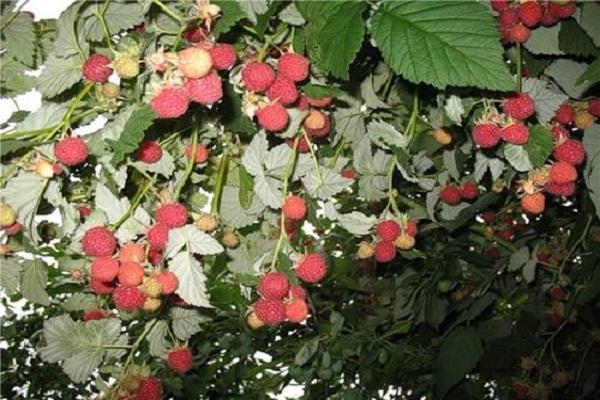
Main positive and negative aspects
The characteristic of Raspberry Hussar includes more positive aspects than negative ones. Therefore, many gardeners choose a crop for cultivation. After all, the variety:
- unpretentious in care;
- high-yielding;
- able to grow in regions with cold winters and dry summers;
- universal for its purpose;
- with berries that tolerate transportation well and do not lose their presentation.
The disadvantage of raspberries will be the spreading of tall bushes that take up a lot of space on the site. You have to tie up the shoots, and cover them for the winter, saving them from icing.
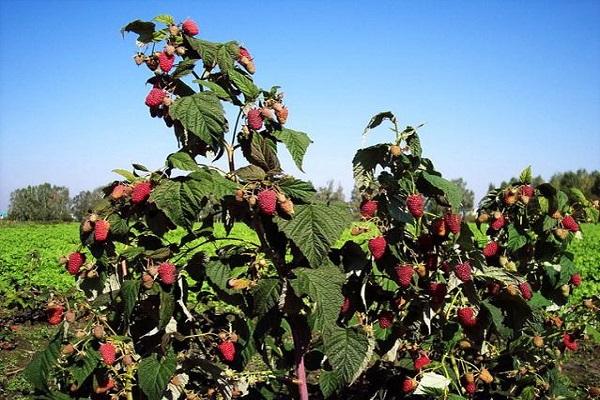
How to properly grow raspberries
Agrotechnology of raspberry Gusar is not much different from the methods of cultivation of other varieties. It is necessary to properly plant a plant in order to grow a remontant type of culture.
Seat selection
For raspberries, it is better to choose places in the garden, where the sun is not always there, but part of the day. Direct rays of the sun will dry out the leaves and berries. In partial shade, the fruits will pour better. But without the sun there will be little sweetness in them.
You can plant shoots along the fence, then you can do without support for them.
From the soil, loamy or sandy loam is preferable for raspberries.Groundwater can lie on the site at a depth of 1.5 meters, supplying the roots of the plant with moisture. The culture grows poorly on saline and acidic soils.
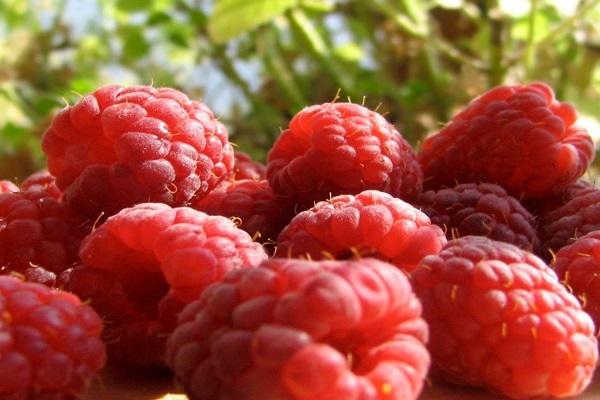
Boarding time
In Siberia, Altai, Urals, it is better to plant raspberries in the spring. As soon as the snow melts, you can prepare seedlings and pits. In warm climates, autumn is used for planting. It is necessary that the bush has time to take root before the onset of cold weather, then it will successfully endure the winter.
Sometimes raspberries are planted in summer using annual root suckers. They are laying a new plantation of a berry plant.
Selection of seedlings
For planting, you need to take such annual offspring, which have a stem thickness at the root collar of 1-1.2 centimeters. Shoots with a root system length of 10-15 centimeters take root better.
The sapling must be cut off, leaving a stem 20 centimeters long with 4-5 buds. Uncut shoots will begin to bear fruit in the year of planting, consuming nutrients and moisture to form berries. In the fall, replacement shoots will not appear, and then the bush will die.

Planting process
The place for raspberries Hussar is cleared of weeds in the fall, dug up. If possible, before processing the steam, 5 kilograms of manure, 40 grams of superphosphate, 20 grams of potassium salt are scattered over 1 square meter. On soils with high acidity, you need to add fluff lime. In the spring, before processing, fertilize the site with ammonium nitrate.
The pits are prepared in advance. They are fertilized if you have not previously carried out work on the preparation of the site. The distance between plants is 1-1.5 meters. Between rows - up to 2 meters.
Raspberries are planted vertically. Planting takes place like this: the seedling is placed vertically, and, holding it with one hand, fill the hole. It is necessary to compact the soil at the end of the procedure and water the plants. It is worth mulching the bushes with a layer of straw, humus, peat in 6-8 centimeters.
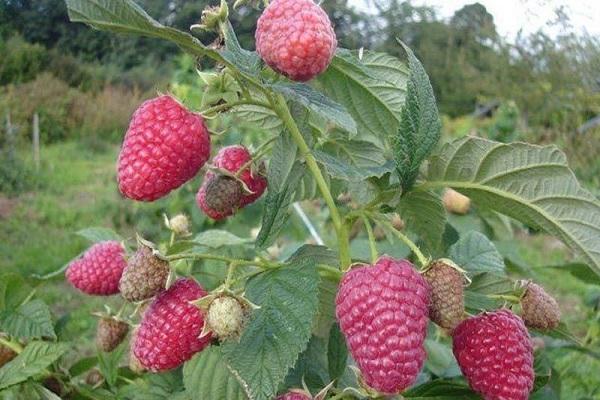
The subtleties of caring for the variety
Raspberry Gusar care is usually carried out. The culture must be watered, fed, cut on time.
Watering and loosening
The yield of raspberries decreases if they do not have enough moisture. In dry summers, water up to 4 times per season. The plant especially needs moisture at the beginning of summer, when setting berries. The last time the plantation is irrigated in October.
Mulching carried out will help to reduce the frequency of watering by up to 2-3 times.
You can water raspberries in furrows and under a bush. You need 2-3 buckets of water per bush, and 3-4 for each meter of furrow. Grooves are laid 50 centimeters from the rows of raspberries. The depth is 10-15 centimeters, the width is 30-40.

After heavy rains and watering, the aisles are loosened, trying not to hurt the roots of the plants. 3-4 treatments are enough to a depth of 5-7 centimeters.
Top dressing and mulching
Raspberry mulch is needed not only to retain moisture in the ground, prevent weed growth, but also to feed. If mulched with peat, humus, then layers are embedded in the soil, supplying raspberry bushes with nutrients.
The cultivation of berry crops requires the introduction of mineral and organic fertilizers. In the spring, you need to water the bushes with a solution of mullein or bird droppings. You can replace organic matter with mineral solutions: 10 grams of ammonium nitrate for a bucket of water, 15 grams of potassium salt. It is necessary to feed the large-fruited variety 2 weeks before the berries ripen. In the fall, be sure to fertilize with superphosphate (50 grams), potassium salt (20 grams). They can be replaced with wood ash, taking 30-50 grams per square meter.
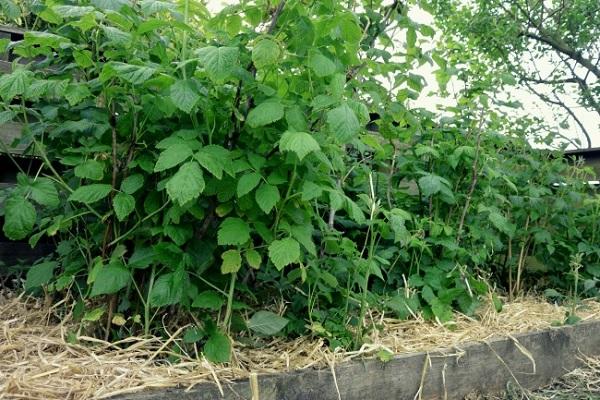
Support
Tall stems of the Gusar variety require a garter to a support. Pegs can be used as it. Then the bushes are pressed against the stakes, tied with twine. But then they will have little light. It is better to prepare a trellis from strong stakes, between which to pull the wire in 2-3 rows.Arrange the raspberry shoots so as to maintain the desired distance between the branches. The fan-shaped garter method or the usual trellis method is often used.
Pruning
In order for the shoots to have enough nutrition, moisture for successful fruiting, they carry out annual pruning of raspberries Gusar. By shortening the tops of annual shoots by 10-15 centimeters, they activate the germination of low-lying buds.
In order to form a bush, up to 15 annual shoots are left 3-4 years after planting, except for those that bear fruit. The rest are carved from the ground. First of all, you need to cut out weak, diseased, damaged branches. Before flowering, the number of shoots is normalized, thinning the bush. Strong root suckers are left to propagate the variety.
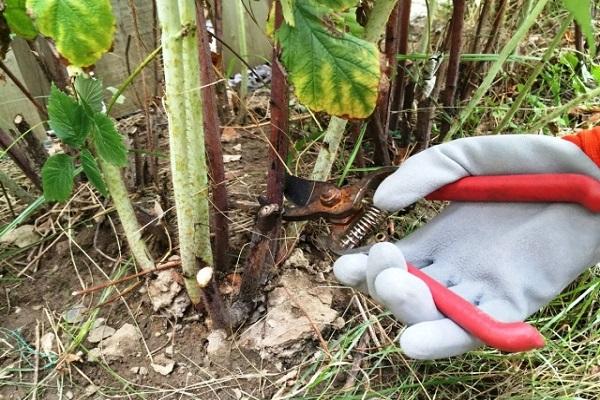
Preparing for winter
In October, the long stems of raspberries are shortened and bent to the ground. The ends must be pinned or covered with earth. It is necessary to cover the crop planting with layers of non-woven material. Young shoots are covered with spruce branches. So the plant will survive the cold winter better.
Ailments and insects affecting raspberries
Usually berry crops are affected by fungal diseases. Symptoms are visible on the leaves. The surface of the leaf plate is covered with brown or whitish spots. It is necessary to spray the bushes with Bordeaux liquid to prevent the onset of the disease or stop the pathological process.
Aphids and spider mites affect plantings of Gusar raspberries when the conditions for growing a remontant culture are not met. Pest control is easy. It is necessary to spray the plants three times with insecticidal solutions or infusion of onion peels, garlic.
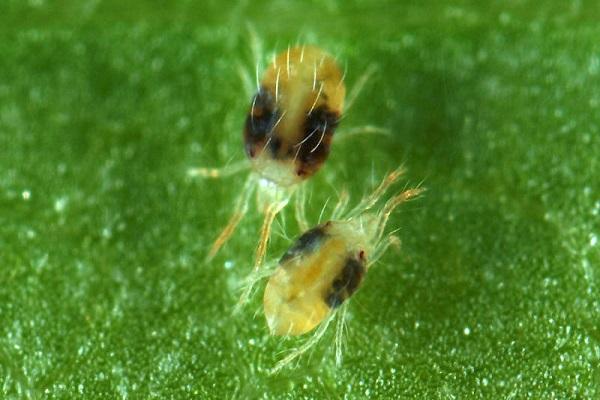
Damage is caused to plantations by raspberry beetle and weevil. To fight adults, larvae dig up the soil in August-September. Spraying with poisons along with laundry soap helps.
How to propagate raspberry hussar
The culture is best propagated in a vegetative way. In early summer, a green cutting 5 centimeters long is cut underground. It is planted in a greenhouse, and when it takes root after 2 weeks, it is fed. It is then necessary to ensure the growth of the cuttings in order to plant them in a permanent place in the fall.
It is easiest to grow a raspberry plantation with root suckers. They are dug up with roots in the summer. Moreover, their length should be 15 centimeters. Suitable for a variety of propagation method by dividing the bush.
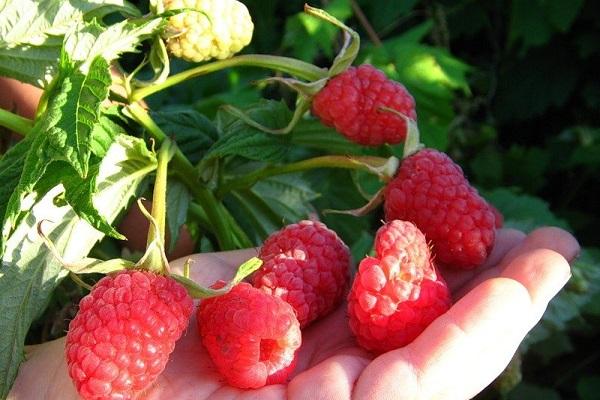
Berry picking and storage
Raspberry Gusar begins to bear fruit in the 2nd year after planting. After a month, the fruits begin to ripen. The crop can be harvested within 30 days. Remove the berries without a stalk, putting them in baskets. Harvests are used for making jams, compotes. Fresh raspberries are useful, but they cannot be stored for a long time. It will stay in the refrigerator for 1-2 days.
